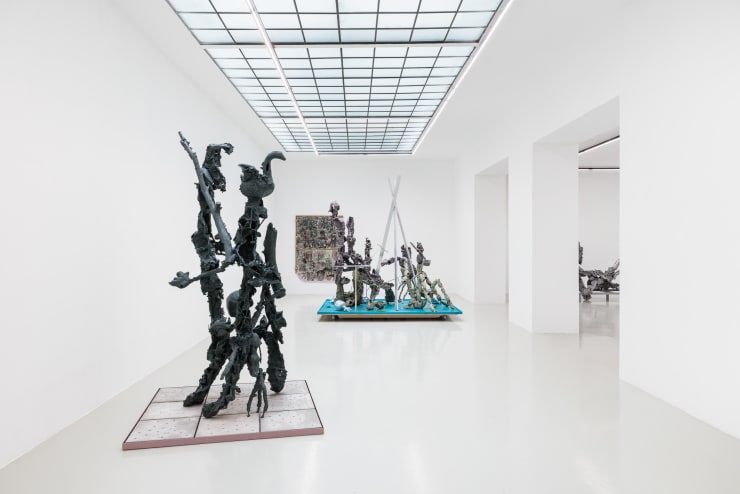Karl Karner | Fichtengrau
Past exhibition
Overview
You humans. You, with your names!
Every thing needs its name, you say, and you fail to realize that giving a name is always a form of taking.
The name is brutal.
It tears the thing out, roots and all, and moves it to another place. I know it only too well:
Every name is a transplantation.
Mum brings 1000 snails to heaven every day, she says. I think heaven is very big.
In the watering can is poison for the snails. We are frugal and only have one.
The forest is full of spruces like the garden with snails, both are not from here.
The forest needs us humans, says the farmer and starts the chainsaw, it's a pity that the forest has had to live without us for so long.
Shot 5 birds last week, all were ringed, starting to collect rings - am the only one with this hobby at the moment.
Hammered 80 nails into the spruce, I wonder when it will die?
In the watering can is poison for the snails. We are frugal and only have one.
The forest is full of spruces like the garden with snails, both are not from here.
The forest needs us humans, says the farmer and starts the chainsaw, it's a pity that the forest has had to live without us for so long.
Shot 5 birds last week, all were ringed, starting to collect rings - am the only one with this hobby at the moment.
Hammered 80 nails into the spruce, I wonder when it will die?
That's the way it is.
But I grow into your names and out of them.
Where the names end, I begin to speak.
Text excerpt: Lea Wintterlin Quotes: Karl Karner
Works
-
 Karl KarnerFGH, 2024bronze240 x 230 x 200 cm
Karl KarnerFGH, 2024bronze240 x 230 x 200 cm
94 1/2 x 90 1/2 x 78 3/4 in -
 Karl Karnerfichtengrün, 2023AluminiumHöhe: 265 cm
Karl Karnerfichtengrün, 2023AluminiumHöhe: 265 cm -
 Karl KarnerFichtengrau, 2023Aluminium235 x 150 x 164 cm
Karl KarnerFichtengrau, 2023Aluminium235 x 150 x 164 cm
92 1/2 x 58 5/8 x 64 5/8 in -
 Karl KarnerI think we have a good time, 2024aluminum, silicone, mud, swarovski dust, plants230 x 290 x 280 cm
Karl KarnerI think we have a good time, 2024aluminum, silicone, mud, swarovski dust, plants230 x 290 x 280 cm
90 1/2 x 114 1/8 x 110 1/4 in -
 Karl Karnerfichtensand , 2024aluminum, sand, wood114 x 40 x 40 cm
Karl Karnerfichtensand , 2024aluminum, sand, wood114 x 40 x 40 cm
44 7/8 x 15 3/4 x 15 3/4 in
(pedestal: 74 x 41 x 36 cm) -
 Karl KarnerBlock 2024/Fichte, 2024drawings, wax, wood, brass, silicone204 x 155 cm
Karl KarnerBlock 2024/Fichte, 2024drawings, wax, wood, brass, silicone204 x 155 cm
80 1/4 x 61 in
Press release
The biomorphic sculptures of Karl Karner in his new exhibition "fichtengrau" at Galerie Kandlhofer greet visitors in a larger-than-life and almost intimidating manner. Resembling fantastical-futuristic life forms (or landscapes?), these works, made of aluminum and bronze cast, exhibit finely branching structures and an organic surface, leaving behind a highly fragile impression.
The reference to nature, particularly botany, is obvious, as the artist clearly names each work in relation to it. The resilient spruce serves as the namesake for Karner's nearly three-meter-high sculptures, titled "Fichtengrau" or "fichtengrün." While evoking a clear image, the exhibited works only partially reflect this image in an altered form. Despite vaguely resembling dead trees in their vertical arrangement and barren appearance, the unconventional, almost bizarre forms of the sculptures immediately disrupt this clear image. They are based on concrete references from the animal and plant kingdom, such as mushrooms, branches, tree bark, or vineyard snails, which the artist combines into grotesque sculptural growths through casts. Additionally, fragmentary references to human intervention are hinted at when the individual elements are assembled into artistic assemblages. The idea of choreography becomes apparent when observing the sculptures.
From a distance, the figurative silhouette of the objects initially comes to the forefront, only to reveal upon closer inspection a multitude of diverse organic forms, inevitably drawing the viewers' gaze into the depths of surreal landscape scenes. These are partly patinated and partly covered with clay slip by the artist. The result is an aesthetically homogeneous overall impression that almost gives the sculptures a classical appearance. From their observer position, humans gaze upon an artistic amalgam of our reality, distorted almost beyond recognition, frozen in the moment of its creation. Karner's reflections on the interplay between humans and nature seem to materialize in the sculptures: starting from the concrete motif of the spruce, which, as a particularly robust tree species in the 20th century, was predestined for reforesting forests, the full extent of human mismanagement of the past decades is vividly brought to light. In the face of climate change, tragically, the spruce is one of those tree species most severely affected by global warming.
It is an observational glance at our present rather than a clear critique that Karner undertakes here – pessimism is foreign to the artist; rather, delicate signs of hope become discernible as individual shoots sprout from the underground of one of his sculptures. Karner has prepared the ground of specific works with seeds, the watering of which he personally undertakes. Consequently, during the exhibition period, the sculpture will undergo a metamorphosis that symbolizes the human potential to counteract the damage already done by showing mindfulness towards nature and not remaining indifferent.
Text by Sergey Harutoonian
Installation Views
Video













